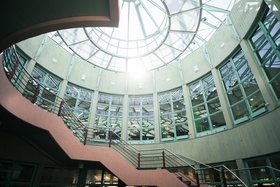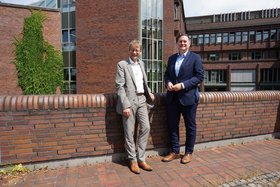Hamburg University of Technology listed as a historic monument
Audimax, Technikum and other buildings are "historically significant ensemble"
21.06.2023

As part of the inventory project "Architecture in Hamburg from 1975-1995", the Office for the Protection of Historical Monuments has listed the oldest parts of the campus of the Technical University of Hamburg - the library, Audimax and Mensa (buildings J, I, architects Jörissen und Partner, landscape architects Arge: Rose + Herzmann + Partner, Schoppe-Andresen, 1981-91), the buildings Denickestraße 15 and 17 and Eißendorfer Straße 40 and 42 as research buildings with laboratories and offices (buildings K, L, M, N, by architects Krebs and Jäger, landscape architects Heimer, Montag, Herbstreit, 1981-87) and the building at Eißendorfer Strasse 38, the technical center, (Building O, Horst Reimann, 1979-82) together with open spaces were listed this spring as a historically significant ensemble of postmodern architecture (site plan: www.tuhh.de/tuhh/tu-hamburg/campus). During a press tour with representatives of the Office for the Protection of Historical Monuments and the Technical University of Hamburg, Senator of Culture Dr. Carsten Brosda and Prof. Dr.-Ing. Andreas Timm-Giel, President of the Technical University of Hamburg, informed themselves about the history of the university buildings and the monument significance of the university.
The Technical University of Hamburg, founded in 1978, is one of the youngest technical universities in Germany and was established at a time when financial resources were scarce and university foundations were rare. The decision to found a technical university was an important one in view of the need for well-trained specialists for the development of Hamburg as an industrial location. As a campus university in the middle of a residential neighborhood, the large-scale building structures - often prefabricated - that had been common at other universities until then were dispensed with, and the necessary space was cleverly built as brick buildings broken up around courtyards and embedded in a beautiful park with a lake. The area situated on the slope is characterized by a generous staircase, a square - the forum - and green terraces.

The innovative formation of research groups and the interdisciplinary work associated with it, together with a prioritization of research for industry, which was already intended when the university was founded, is reflected in the building design. Both the architectural and the horticultural design, as well as the works of art on the campus, some of which are of the highest caliber, demonstrate the aspirations that the young university had and which it succeeded in fulfilling. As a "city within the city", the Technical University, as politically intended, gave important impulses for the development in the Süderelberaum and still shapes the neighborhood in terms of urban development.
Dr. Carsten Brosda, Senator for Culture and Media: "The Technical University of Hamburg is not only an important institution of the Hanseatic City due to its importance for science and teaching as well as industry, as a campus university in the middle of the residential district it also shapes the district in a very special way through its garden and architectural design. In addition, it is an outstanding example of how innovative ideas in education and research, with the possibility of interdisciplinary work, are also reflected structurally. With the designation as a protected building within the scope of the inventory project 'Architecture in Hamburg from 1975-1995', we have secured the preservation of the buildings and with them a piece of important city history. I am pleased that there are already very constructive discussions between the university and the Office for the Protection of Historical Monuments on how the protected buildings can be further developed in the future."
Prof. Dr.-Ing. Andreas Timm-Giel, President of the Hamburg University of Technology: "We are proud of our now listed campus, which facilitates the important interdisciplinary research and learning in the engineering sciences in a special way. The buildings are still highly functional today, at the same time timelessly appealing, and give the TU a special DNA. Learning and researching for 'technology for people' is a great pleasure on this campus. We want to further develop the TU Hamburg and its beautiful campus, to develop engineering solutions against climate change and its consequences, and to include the campus in the process. Here we are pleased about the constructive cooperation with the monument protection."
About the inventory project of the Office for the Protection of Historical Monuments
Since 2020, the Office for the Protection of Historical Monuments has been reviewing properties from the years 1975 to 1995 in a comprehensive project with the aim of recording, researching and, if necessary, placing under protection the architectural and garden monuments of this period. In this way, the Office for the Protection of Historical Monuments is fulfilling its task of examining the building stock for its cultural monuments after about one generation (30 years). The aim of the project is to add authentically preserved buildings and gardens to the city's list of monuments and to protect the existing stock.
TUHH - Public Relations Office
Kaja Weber
E-Mail: kaja.weber@tuhh.de







